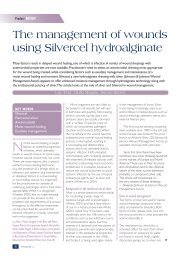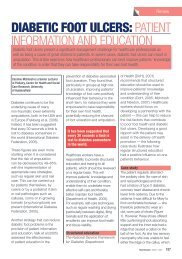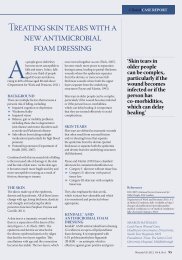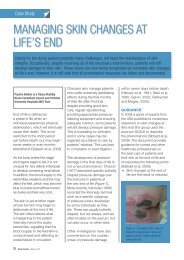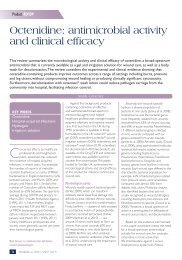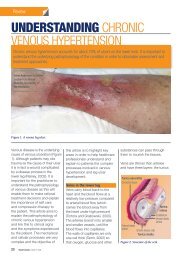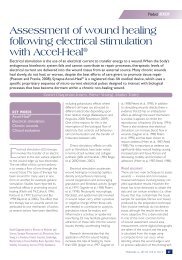Are pressure ulcer grading & risk assessment tools useful?
Are pressure ulcer grading & risk assessment tools useful?
Are pressure ulcer grading & risk assessment tools useful?
You also want an ePaper? Increase the reach of your titles
YUMPU automatically turns print PDFs into web optimized ePapers that Google loves.
Clinical REVIEW<br />
Table 2<br />
Predictive validity of <strong>risk</strong> <strong>assessment</strong> scales<br />
Scale Author Sensitivity Specificity<br />
Braden Bergstrom et al, 1992 (short stay)<br />
Bergstrom et al, 1992 (ICU)<br />
Braden et al, 1994 (nursing home)<br />
Langemo et al, 1991 (orthopaedic)<br />
Barnes et al, 1993 (cardiothoracic)<br />
100%<br />
83%<br />
46%<br />
64%<br />
73%<br />
90%<br />
90%<br />
88%<br />
87%<br />
91%<br />
Waterlow Smith, 1989 73% 38%<br />
Norton Norton et al, 1962 (elderly care)<br />
Goldstone et al, 1982 (orthopaedic)<br />
Smith, 1989 (orthopaedic)<br />
63%<br />
89%<br />
50%<br />
70%<br />
36%<br />
31%<br />
the Norton scale has little research to<br />
endorse its use outside of an elderly<br />
care setting. Furthermore, subsequent<br />
modified versions of this tool have<br />
incorporated nutrition as a <strong>risk</strong> factor,<br />
highlighting recent research alluding to<br />
the importance of nutrition and wound<br />
healing, and have also stratified the<br />
degrees of <strong>risk</strong> (Wai-Han et al, 1997;<br />
NMPDU, 2002; EPUAP, 2003).<br />
The Braden Scale<br />
The Braden Scale was devised by<br />
American researchers in the mid-1980s.<br />
Following an extensive literature search,<br />
the foundation for this tool was based<br />
on a ‘conceptual schema of aetiological<br />
factors’ whereby ‘<strong>pressure</strong>’ and ‘tissue<br />
tolerance’ were identified as significant<br />
factors in <strong>pressure</strong> <strong>ulcer</strong> development.<br />
Six further parameters were identified<br />
as <strong>risk</strong> factors that could contribute to<br />
<strong>pressure</strong> or affect the tissue tolerance<br />
of the skin. The range of possible total<br />
scores when using this tool varies<br />
between 6 and 23 and, like the Norton<br />
scale, low scores signify higher <strong>risk</strong>.<br />
The cut off points that signify that an<br />
individual is ‘at <strong>risk</strong>’ varies between<br />
16 and 18, depending on the clinical<br />
environment in which the tool is being<br />
used (Bergstrom et al,1987).<br />
One criticism of this tool is the inability<br />
of staff to distinguish what is meant by<br />
some of the parameters. An example<br />
of this is the use of <strong>risk</strong> factors, such<br />
as ‘mobility and activity’, whereby<br />
the authors use the term ‘mobility’<br />
to question if the patient is able to<br />
relieve <strong>pressure</strong> through movement?<br />
Whereas, the ‘activity’ parameter relates<br />
to the frequency and duration of a<br />
patient’s movement. So, in actual fact,<br />
the terms mean different things but<br />
further clarification or education may be<br />
required at ward level. Unlike the other<br />
<strong>pressure</strong> <strong>ulcer</strong> <strong>risk</strong> <strong>assessment</strong> <strong>tools</strong>, the<br />
Braden scale has been widely researched<br />
within different clinical environments,<br />
as illustrated in Table 2. However, it is<br />
evident that the predictive validity of<br />
the Braden scale is not consistently high<br />
for all clinical areas (Capobianco and<br />
McDonald, 1996).<br />
The Waterlow Scale<br />
In 1987, Judy Waterlow devised the<br />
Waterlow scale following an extensive<br />
literature search and pilot studies within<br />
her local areas. She felt that the Norton<br />
scale did not address nutritional issues,<br />
account for underlying pathology, or<br />
highlight the <strong>risk</strong> of patients undergoing<br />
surgical procedures. In comparison<br />
to the Norton and Braden scale, the<br />
Waterlow scale identifies significantly<br />
more <strong>risk</strong> factors in the <strong>assessment</strong><br />
tool, resulting in a possible total score<br />
ranging between 4 and 40. High scores<br />
signify high <strong>risk</strong> (10+ = at <strong>risk</strong>; 15+ =<br />
high <strong>risk</strong>; 20+ = very high <strong>risk</strong>). Judy<br />
Waterlow also went to considerable<br />
effort to ensure that her tool was<br />
user friendly and, by incorporating<br />
information on methods of how to<br />
prevent <strong>pressure</strong> <strong>ulcer</strong> development,<br />
she encouraged staff to be proactive<br />
in the prevention and management<br />
of <strong>pressure</strong> <strong>ulcer</strong>s (Waterlow, 1988;<br />
Waterlow, 1998). However, despite its<br />
wide use within the UK, the Waterlow<br />
scale has been criticised for its lack<br />
of research and its ability to overpredict<br />
and, consequently, result in the<br />
misuse of resources (Edwards,1995;<br />
McGough,1999).<br />
More recently, Judy Waterlow has<br />
revised her original version of the<br />
Waterlow scale following collaboration<br />
with colleagues in Australia. She has<br />
made a few amendments as listed in<br />
Table 3 (Waterlow, 2005). In addition,<br />
she has produced a manual to clarify<br />
many of the ‘grey areas’ that arose<br />
from use of the original tool. However,<br />
once again, research is eagerly awaited<br />
to assess the revised Waterlow scale’s<br />
effectiveness in clinical practice.<br />
Which <strong>risk</strong> <strong>assessment</strong> tool is the best?<br />
The simple answer is that there is no<br />
‘best’ <strong>pressure</strong> <strong>ulcer</strong> <strong>risk</strong> <strong>assessment</strong><br />
tool. Experts have been unable to<br />
unequivocally endorse one specific<br />
tool for all clinical areas, due to a lack<br />
of robust research (EPUAP, 1998;<br />
RCN, 2000; NMPDU, 2002). So how<br />
can we decide which tool is the most<br />
appropriate for our clinical area? It is<br />
important to consider the predictive<br />
validity of a tool when either piloting <strong>risk</strong><br />
<strong>assessment</strong> <strong>tools</strong> within a clinical area,<br />
or when reviewing the literature. The<br />
predictive validity assesses the efficacy<br />
of a tool at differentiating between<br />
individuals who are at <strong>risk</strong> and those<br />
who are not, and this is achieved by<br />
measuring the sensitivity and specificity<br />
of a tool.<br />
The sensitivity looks at the accuracy<br />
of the tool in predicting those who<br />
will develop the condition; the ideal<br />
tool would achieve a score of 100%.<br />
Similarly, specificity aims to ascertain<br />
a tool’s ability at predicting those who<br />
will not develop a <strong>pressure</strong> <strong>ulcer</strong>, thus<br />
avoiding over prediction and a waste<br />
of resources. Once again, the ideal<br />
score for specificity would be 100%.<br />
Another factor to consider when<br />
looking at the research is inter-rater<br />
reliability, to ensure that different levels<br />
of staff can use the tool and achieve<br />
a similar outcome, thereby minimising<br />
the <strong>risk</strong> of huge discrepancies arising.<br />
Finally, when reviewing the literature,<br />
it is important to acknowledge the<br />
methodology of the study and to<br />
consider who has been involved in the<br />
88 64 Wounds UK



